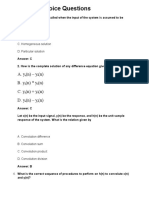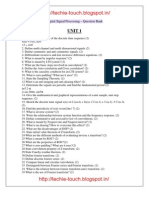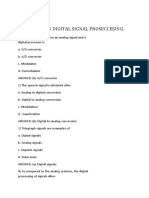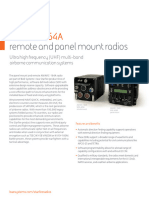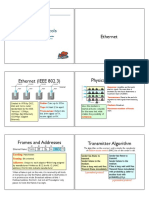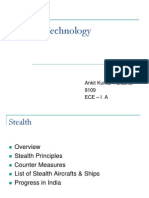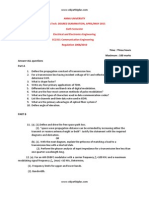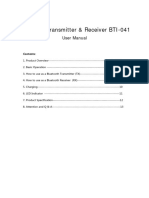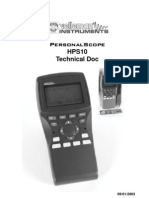Question Bank DIGITAL SIGNAL PROCESSING (OE601)
DIGITAL SIGNAL PROCESSING
Time Allotted: 3 hours Full Marks: 70
The figures in the margin indicate full marks
Candidates are required to give their answers in their own words as far as practicable
Group A
Choose the correct alternatives for any ten of the following: [10 × 1]
Signal System
1) The digital system in y(n) = x(n2) is
a) linear and causal b) linear and non-causal
c) non-linear and causal d) non-linear and non-causal
2) If x*(n) is the complex conjugate of x(n) then
2
x * ( n)
2
a) x(n) c) x (n ) =x( n) .x*(n)
2
c) x (n ) =x( n) .x*(n) d) none of these
3) The energy of constant amplitude complex valued exponential function
x(n) =A exp(jnω) where A and ω are constants ,is given by
A2 A2 A2
a) A2 b) c) d)
2 2
4) Infinite memory system is also known as
a) FIR system b) IIR system
c) Digital system d) Analog system
5) On digital differentiation of unit ramp sequence Ur (n) , one obtains
a) unit impulse sequence b) unit ramp sequence
c) unit step sequence d) none of these
6) If x1(n) and x2(n) are finite length sequences of sizes L and M respectively, their linear convolution
has the length
a) L+M-2 b) L+M-1
c) L+M d) max{L,M}
7) If x(n) is a complex sequence, then
a) each sample value of x(n) is complex
b) some sample values of x(n) must be complex
c) at least one sample value should be complex
d) no sample value has real component
8) For a system with output –input relationship as y(-n)= x(n-1)
-1-
� Question Bank DIGITAL SIGNAL PROCESSING (OE601)
a) the system is causal for all n
b) the system is linear and causal for all n
c) the system is stable ,linear and causal for all n
d) none of these
9) Zero padding indicates
a) zero appearing in x(k) sequence
b) value of x(k) is zero
c) dummy samples added with zero value in x(k)
d) none of these
10) The convolution of u(n) with u(n-4) at n=5 is
a) 5 b)2 c)1 d) 0
11) A causal system always has
a) right side sequences b) left side sequences c) both side sequences d) none of these
12) If Fsi is the minimum sampling rate , Fmax is the highest frequency available in the analog signal, then
at Nyquist rate.
a) Fsi = Fmax b) Fsi = 2Fmax c) 2Fsi = Fmax d) None of these
13) Zero padding a signal
a) reduces aliasing b) increase time resolution c) increase frequency resolution d) has no effect
14) A discrete –time LTI system is known as causal system if its
a) impulse response h(n) is zero for n<0
b) impulse response h(n) is zero for n> 0
c) impulse response h(n) is positive for n<0
d) None of these
15) Stability criteria for a discrete time LTI system is
a) H(n)>1 b) H(n)<1 c) H(n)=1 d) H(n)=0
16) is
a)Energy signal b) power signal c) both (a) and (b) d) none of this
17) The system y(n)= x(n) + nx(n+1) is
a) Linear time invariant
b) Non-Linear time invariant
c) Linear time variant
d) None of this
18) A signal is a power signal if a) E<∞,P=0 b) P<∞,E=0 c) P<∞, E=∞ d) P=∞,E=0
19) The sequence x(n)= (-1)n is periodic with a period of
a) 6 samples b) 4 samples c) 2 samples d) 0 samples
2 n
20) The fundamental period of the sequence x ( n) cos( )
3
a) 1 b) 2 c) 3 d) 6
2n
21) e U(n) is
(A) energy signal (b) power signal (c) both of these (d) none of these
22) The convolution sum is
-2-
� Question Bank DIGITAL SIGNAL PROCESSING (OE601)
(a) y(n)=x(n)*y(n) (b) y (n) x ( k ) ( n k )
k
(c) y (n) x ( k ) h( n k )
k
(d) y (n) x ( k ) h( k )
k
Z-transform
23) If X(k) is Z transform of x(n), then Z transform of x(n-k) is
a) Zk X(k) b) Z-k X(k) c) Z1/k X(k) d) Z-1/k X(k)
24) The z-transform of δ(n) is
1 1
a) b)
(1 z 1 ) z
c) 0 d) 1
25) The z-transform of u(-n) is
1 z
a) b)
(1 z 1 ) (1 z )
1 1
c) d)
(1 z ) ( z 1)
26) If ROC of the Z transform of a sequence is outside the unit circle of radius r then the sequence is
(a) growing (b) non-casual (c) decaying (d) casual
x(n) sin nu (n)
27) The Z-Transform of 2 is
Z Z2 1 Z
(a) Z 1 (b) Z 1 (c) Z 1 (d) Z 1
2 2
DFT and FFT
28) If the fourier transform of x(n) is X(w), then the fourier transform of nx(n) is
dx ( w) dx( w) dx ( w)
a) j b) j c) d) none of these
dw dw dw
29) If x(k) represents the 8-point DFT of x(n)={1,1,1,1,1,1,0,0}, x(0) is
a) 3 b) 1 c) 6 d)0
30) If x[n]= {1,0,0,1} , the DFT value of X (0) is
a) 2
b) 1+j
-3-
� Question Bank DIGITAL SIGNAL PROCESSING (OE601)
c) 0
d) 1-j
31) The Fourier transform of an aperiodic discrete time sequence is
a) Discrete and periodic function of frequency
b) Discrete and aperiodic function of frequency
c) Continuous and periodic function of frequency
d) Continuous and aperiodic function of frequency
32) The Fourier transform of δ(n) is
a) 1 b) 0 c) π δ(ω) d) δ(ω)
33) Overlap save method is used to find
a) circular convolution
b) linear convolution
c) DFT
d) Z transform
34) If X(K) represent the 8 point DFT of x(n)={1,1,1,1,1,1,0,0} then X(0) is
(a)3 (b) 6 (c)1 (d)0
35) The value of twiddle factor W84 is given by
1 j
(a) 1 (b) –J (c) (d) -1
2 2
IIR and FIR Filter
36) For rectangular window used for designing FIR filters,the peak amplitude of the side lobe is
a) -40dB b) -3dB c) 0dB d) -13 dB
37) Fir filter is
a) Recursive and linear
b) Non-Recursive and linear
c) Recursive and non-linear
d) None of this
38) System function of digital filter expressed as H(z)=Bkz-k represents
a) IIR filter
b) FIR filter
c) Butterworth Filter
d) Chebyshev Filter
39) The mapping from analog to digital domain in impulse invariant method is
a) One to many b) many to one c) one to one d) none of this
40) The pole of chebyshev filter lie a) on an ellipse b) on a circle c) on a parabola d) on a
Rectangle
41) A digital filter is said to be IIR
b) If present output depends on previous output only
c) If system function H(z) has one or more non-zero denominator coefficients
d) If all the poles lie outside the unit circle
e) If system function has only zeros.
-4-
� Question Bank DIGITAL SIGNAL PROCESSING (OE601)
Group B
Answer any THREE questions (5x3=15)
Signal and System
1) For a causal LTI system , the output y(n)= 14 y (n 1) x(n) . Calculate y(n) while
a) x(n)= n3u(n+1)
2) Determine the linear correlation y(n) of the signals
1, 3 n 6 1 4 n 3
x(n)= and h(n)=
0 elsewhere 0 elsewhere
3) Classify the different types of systems with suitable example.
4) The impulse response of a linear time invariant system is h(n) = {1,2,1,-1}.Determine the response of
the system to the input signal x(n)={1,2,3,1} using linear convolution.
5) State Perseval’s energy theorem.
6) a)Define convolution sum.
b) Determine whether the following signal is energy or power or neither energy nor power
signal: x(n)= [2+3]
7) a)What is the necessary and sufficient condition for system stability?
b)Determine whether or not the following system is LTI:
i) Y(n)=cos[x(n)] [1+4]
8) a)Define energy and Power signal.
1
b) Calculate the power of signal sequence given by : x( n) ( ) n u (n)
3 [2+3]
9) Find the convolution sum of the signals:
i) x(n)= 1,n=-2,0,1
= 2, n=-1
=0, elsewhere
ii) h(n)= δ(n)- δ(n-1)+ δ(n-2)- δ(n-3)
10) Find y(n) if x(n )=n+2 for 0<n<3
h(n)=anu(n) for all n
11) When a system is said to be BIBO stable?
Find whether the system with impulse responds h(n)=2e-2n is stable or not.
-5-
� Question Bank DIGITAL SIGNAL PROCESSING (OE601)
DFT and FFT
1) Calculate the magnitude and phase of the fourier transform of the signal
i) x(n) = (0.5)nu(n-1) and plot them as function of frequency.
2) If x(n) ={1,3,2} and y(n)={1,2}.Find the linear convolation x(n)*y(n) using DFT based approach.
3) Find out the DFT of x(n)={2,1,2,1}
i) Determine the fourier transform of the signal:
(a) x(n)=3n u(-n) -3-n u(n)
4) Find out the DFT of x(n)={1,1,0,0}
5) If fourier transform of x(n) is X(jω) , then prove that
(1) a)x(-t)↔X(-jω)
(2) b)x(at)↔
Z-transform
1) Explain the relationship between S-plane and Z-plane.
1 3z 1
Find the Z-inverse of χ(Z) = z 2
2) 1 3z 1 2 z 2
3) Prove that an LTI system is BIBO stable if and only if the ROC of the system function includes
unit circle.What is the stability condition for the system function h(n)=αn ?
4) Find the relation between fourier transform and laplace transform with Z-transform.
5) Given the following transfer function T(z) of a DSP system,write the difference equation:
T(z)=
6) State the property of convergence for Z-transform
7) Find out X(n) which Z-Transform is
Z3
X (Z )
( Z 1)(Z 1) 2
7) Define ROC.
8) Determine the Z-transform and ROC of the following signal
(a) X(n)= [1+4]
-6-
� Question Bank DIGITAL SIGNAL PROCESSING (OE601)
IIR and FIR filter
1
1. For the analog filter having transfer function h(s)= . Determine H(z) using impulse
s( s 1)
invariance method.
2. Apply Bilinear transformation to H(s)= with T=0.1s
3. How do you take care of the warping effect for designing an IIR filter using bilinear
transformation?
0.5(1 z 1 )
4. Convert the single pole lowpass IIR filter with system function H(Z)= into band pass
1 0.302Z 1
filter with upper and lower cutoff frequencies ωu and ωl respectively. The low pass filter has 3
dB band width . ωu =3П/4 , ωl =П/4 , ωp =П /6 . ωp is the passband frequency
5. Write down the procedure for designing FIR filter using frequency sampling method.
6. Define phase delay and group delay.
7. The length of an FIR filter is 13. If the filter has a linear phase ,show that
Group C
Answer any THREE questions (15x3=45)
Signal and System
1) a) Discuss in brief the effect of Finite Register Length in Digital Signal Processing. [4]
e) Using Linear Convolution find y(n)=X(n)*h(n) for the sequence
X(n) = { 1,2,-1,-2,0,1,3,-1) and H(n)=(1,2) . Compare the result by solving the
problem using (a) Overlap Save Method (b) overlap Add method [7]
c) For the difference equations in which x(n) is input and y(n) is output
y(n) = 3y2 (n-1) – nx(n) +4x(n-1) – 2x(n-1)
Determine whether system is i) Linear ii) time-invariant iii) Causal. In each case justify the
answer. [4]
-7-
� Question Bank DIGITAL SIGNAL PROCESSING (OE601)
2) a) Find the system function and impulse response of the system described by the difference equation
y(n) =x(n) +2x(n-1)-4x(n-2) + x(n-3)
0.2 z
b) Find the inverse z-transform of X(z)= , z 1
(0.5 z )( z 1)
c) What is zero padding ? What is its use? [5+5+5]
3) (a) Compute the responds of the system y(n)=7y(n-1)-0.12y(n-2)+x(n-1)+x(n-2) to input x(n)=nu(n). Is
system stable?
b) What is ROC? State its properties.
c) what is relation between Z-transform and DTFT?
DFT and FFT
1) a)Compute the DFT of a sequence(-1)n for N=3 [4]
b) Explain the decimation in time FFT algorithm. [7]
c)Find the order of the Butterworth filter that has a -2dB passband attenuation at a
frequency of 20 rad/sec and -10dB stopband attenuation at 30 rad/sec. [4]
2) a) Given x(n) ={1,2,3,1,1,2,2,1}, find X(k) and the DFT coefficients using
decimation-in-time FFT algorithm. [7.5]
b) Derive the expression for frequency response of raised cosine window sequence used for design of
FIR filter. [7.5]
3) a) A signal x(n) has the fourier transform : X(ejw) =1/(1-ae-jw).Determine the fourier transforms of
following signals:
i)e nπ/2 x(n+2) ii)x(-2n) [8]
b) Compute the 4-point DFT of the signal x(n)= e jnπ/2. Verify the result by computing its IDFT. [7]
4) a)Find the circular convolution of two sequences x1(n)={1,1,2,2} and x2(n)={1,2,3,4,5}
b)State and prove initial value theorem regarding Z-transform
c) Compute DFT of the sequence x(n)={1,0,0,1} [7+3+5]
5) Let x(n)=0 ,0<n<N-1 be sequence with an N-point DFT X(k); 0≤k≤N-1:
a) If x(n) is symmetric sequence satisfying the condition x(n)=x(N-1-n), show that X(N/2)=0, for N
even.
b) If x(n) is symmetric sequence satisfying the condition x(n)=-x(n-1-n) show that X(0)=0 ,for N
even.
c) If N is even and x(n)=-x(n+N/2), then X(k)=0 for k even. [5+5+5]
6) a) Find the DFT of the sequence {1,1,1,1,2,2,2,2} using radix-2 Decimation–in–time FFT.Sketch the
magnitude and phase plot.
-8-
� Question Bank DIGITAL SIGNAL PROCESSING (OE601)
b) What is the need of FFT?
c) What is bit –reversal? [5+5+5]
7) ) Compute the 4-point DFT of the signal x(n)= {1/2,1/2,1/2,1/2,0,0,0,0}
Use in place redix-2 decimation in time FFT algorithm.
b) what is butterfly regarding FFT?
c) What are the difference and similarities between DIT and DIF algorithms?
Z-transform
1) a) Using Bilinear transformation , design a high –pass filter monotonic in pass band with a cut –off
frequency of 1 Khz and down by 10 dB at 350 Hz while sampling frequency is 5 kHz. [7]
b)Determine the Z-transform of the following signals and indicate their ROC along with pole zero
plots.
i) x(n)= (an cos ω0n)u(n)
ii) x(n)= an u(n) + bnu(-n-1), a b [4+4]
2)a)What is ROC ? State its properties.
b)Find the system function and impulse response of the system described by
y(n)=x(n)+2x(n-1)-4x(n-2)+x(n-3)
c) Find the inverse Z-transform of
X(z)= ;2<z<3
d) Prove that an LTI system is BIBO stable if the ROC of system function includes the unit circle.
[2+5+5+3]
3) Find the Z- transform and the region of convergence of the signal
a) x(n)= b nU (n 1)
1
b) x(n)= ( ) n 1 u ( n 1)
3
c) Obtain the structures of cascade and parallel realization of the following transfer function:
(1 z 1 ) 3
H ( z) [5+5+5]
1 1 1 1
(1 z )(1 z )
8 2
4) a)If a discrete time LTI system is BIBO stable, show that the ROC of its system function H(z) must
contain the unit circle ie
b)Determine the output sequence of the system with impulse response h(n)= ,when the input
is the complex exponential sequence
-9-
� Question Bank DIGITAL SIGNAL PROCESSING (OE601)
1. x(n)=Aejπ ; -∞<n<∞ [7+8]
IIR and FIR filter
1) a) Determine the direct form of realization of a linear phase FIR filter specified by the impulse
response h(n)= {1,2,3,3,3,2,1} [5]
b) Draw i) direct form I ii) direct form II iii) cascade iv) parallel structures
for the system described by the difference equation
3 1 1
(1) y(n) = y(n-1) - y(n-2) +x(n) + x(n-1) [10]
4 8 3
2) a)What is the advantage of linear phase realization of FIR system. [3]
b) A low –pass filter is to be designed with the following desired frequency response
e j 2 / 4 / 4
H(ejω)=
0, / 4
Determine the filter coefficients h(n) if the window function is defined as
1 , 0 n 4
ω(n)=
0, otherwise
Also determine the frequency response H(ejω) of the designed filter. [8]
c) Find ROC and plot the pole and zero for anu(n) using Z-transform. [4]
3) a) What is meant by order of a filter? [3+6+6]
a) Design a digital Butterworth IIR filter for the given frequency response
(a)
0.85≤|H(ejω)| ≤1 for 0≤ω ≤0.2π
(b) |H(ejω)| ≤0.02 for 0.45 π ≤ω ≤π
Use Impulse Invariant method.
4) a) Discuss about design method of low pass filter.
b) What do you mean by Windowing?
b) What is rectangular window?
c) How are rectangular windows used to design FIR filter ?
e) Determine the IDFT of Y (k) ={1,0,1,0} [4+2+2+4+3]
5) a) Convert the following analog filter with H(s) = (s+0.1)/ [(s+0.1)2 +16] into a digital IIR filter by
means of bilinear transformation. The digital filter is to have a resonant frequency ωr =π/2
- 10 -
� Question Bank DIGITAL SIGNAL PROCESSING (OE601)
b) Find the relation between analog frequency and digital frequency due to bilinear transformation
c) What do you mean by wraping and prewarping? [4+3+4+4]
d) What is the difference between linear and circular convolution?
6) a) Differentiate between overlap save method and overlap add method.
b) Differentiate between FIR and IIR filters [5+5+5]
c) Write down the advantages of bilinear transformation over impulse invariance .
7) Draw cascade structures for the system described by the difference by the difference equation
3 1 1
y (n) y (n 1) y ( n 2) x(n) x(n 1)
4 8 3
Design a digital Butterworth filter using the following specifications using bilinear transformation
method
0.8 H ( j) 1 for 0 0.2 pi
H ( j) 0.2 for 0.6 pi pi
[5+10]
8) Design the symmetric FIR lowpass filter using rectangular window for which desire frequency
responds is express as
e j for p
H d ( )
0 0
2
Determine H(z) using impulse invariant method at 5 Hz sampling frequency from H (s)
(s 1)(S 2)
[9+6]
9) Write short notes on [3×5]
a) Circular convolution
b) Utility of FFT over DFT
c) BIBO stability in Z Domain
d) Gibb’s Phenomenon
e) Periodic and aperiodic signal
f) Chebyshev Filter
g) Causal and Non-Causal System
h) Radix-2 DIF algorithm
i) Bilinear transformation
j) Energy and Power signal
k) IIR and FIR filter
l) overlap save method and overlap add method.
[5+5+5]
------------- X -----------
- 11 -
�Question Bank DIGITAL SIGNAL PROCESSING (OE601)
- 12 -














